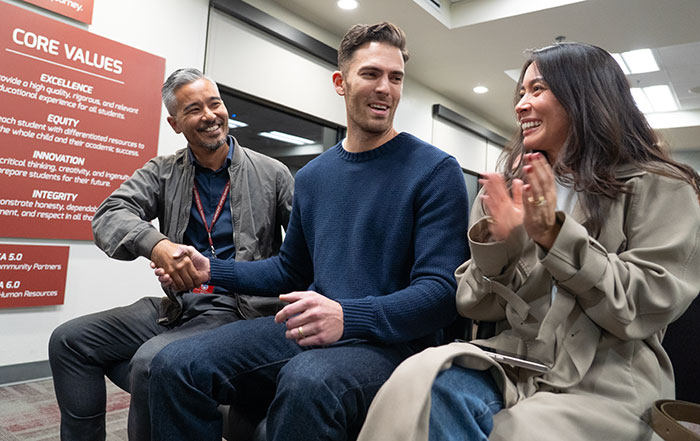Big increase of COVID cases on CUSD campuses
by Mick Rhodes | mickrhodes@claremont-courier.com
After logging a record 174 new COVID cases last week, Claremont Unified School District shattered that dubious mark, recording 264 more this week, as Omicron continues to surge through the community.
At press time CUSD’s COVID dashboard listed 725 total year-to-date student COVID cases spread among the district’s 10 campuses, including San Antonio High, which logged its first five cases. Overall, year-to-date cases jumped 57% over last week’s total of 461.
As always, check the district’s COVID dashboard at https://claremont-ca.schoolloop.com/covid for the latest figures.
The district is so consumed with dealing with the surge of new cases, it’s been unable to keep up with updating the corresponding numbers of quarantined students. Claremont Unified School District Assistant Superintendent, Human Resources Kevin Ward said its accurate to assume there are approximately three quarantined students for each new positive case reported this week, which translates to roughly 792 CUSD students in quarantine as of 4 p.m. Wednesday.
Families have in recent days been voicing frustration regarding delays in receiving test results from the four ongoing district-run testing clinics. Ward said he shares their concern, but the lab that is analyzing the thousands of tests — the district’s weekly clinics usually administer about 250 tests per hour — is experiencing an Omicron surge-related backlog.
The January 3 acquisition of 6,750 rapid COVID test kits (with two tests per kit) from the L.A. County Office of Education has helped by reducing reliance on PCR testing clinics. The district has thus far distributed about 3,420 of the kits to CUSD families, and has 3,300 remaining.
“But it’s also really increased our testing exponentially,” Ward said. “And with that increase in testing you’re seeing the increase in positive cases getting reported. And then the work that goes on to what it takes after those cases are reported, all that [contact tracing], is stretching our staff really thin.”
The priority now is to be sure students and staff who test positive are moved home to quarantine, and to watch the timelines of those quarantines to assure they return to classrooms as soon, and as safely, as possible, Ward said.
The number of CUSD staff out sick — primarily due to various COVID-related causes — has held steady at about 85 since classes resumed last week, Ward said. A typical non-surge weekday would see about 60 staff out sick. This number is crucial, because perhaps the first trigger that could cause schools to close in-person classes and return to distance learning would be a critical lack of teaching staff.
“I mean, obviously that’s going to be one of the most important factors here, is our ability to keep schools operational and keep them safe,” Ward said. “If that changes, and we’re unable to do that, then I think we have to think of a next step. But as long as we’re able to keep everybody here and keep students coming, keep our operations safe, and our health staff is keeping up with the situations and the protocols, I think we’re able to keep operational.”
At Claremont High, where the surge has hit hardest, teachers have been subbing for their sidelined colleagues during their prep periods. And, with student absences spiking, some teachers have been moved around to help with the staff shortages. Administrators have also stepped up to help. It’s a leaky boat, but so far the resources are there to plug the holes.
“If it gets worse, I’m not confident we’ll be able to cover that,” Ward said. “But at least right now with the numbers that we have, and due to a lot of hard work from folks and a lot of scrambling, we’re able to cover that. It’s a day-to-day concern. And certainly if it gets worse, we’re going to struggle to meet those needs. But for right now, we’re doing okay.”
The teacher backup team is more robust at CUSD’s seven elementary school sites, Ward said, due to its extensive roster of substitutes, some of which work exclusively at one school or even for a specific teacher.
Ward again said CUSD has not made plans to move to a testing requirement for all students, as L.A. Unified School District did last week. With about 6,800 students, just 3,300 rapid test kits (with two tests in each package), and PCR labs stretched to the limit, there is currently no mechanism in place that would accommodate a mandatory testing requirement, he added.
“We would need some other allocation of something in order to do that,” Ward said. “Our testing vendor and our lab certainly could not handle at this point the requirement to do a PCR test on all students and maybe all staff. They just don’t have that capacity right now. They’re just flooded. And we don’t have the amount of antigen take-home tests to do that.”
The district’s four weekly afterschool testing clinics have been bustling, but wait times have stayed consistent at about 50 minutes at the most, Ward said.
“Inundated is a good adjective,” Ward said. “They’ve been really full.” The clinics are testing whole households, students, parents, siblings and even grandparents, and not just CUSD folks. It’s a free and open service.
The district’s afterschool test sites and times are Mondays from 2 to 4 p.m. at El Roble Intermediate School, and from 2:45 to 3:45 p.m. at Sycamore Elementary; Tuesdays from 2:45 to 3:45 p.m. at Vista del Valle Elementary; Wednesdays from 1 to 2 p.m. at Sumner Danbury Elementary; and Thursdays from 3:30 to 5 p.m. at Taylor Hall.
More info is at https://claremont-ca.schoolloop.com/covid.
Claremont Colleges go to online classes
The seven Claremont Colleges are set to begin their spring classes Tuesday, January 18, but as a result of the surge in COVID cases due to the Omicron variant, all have recently announced the first two weeks of classes will take place online.
The schools have also implemented testing protocols for returning students and staff.
“Students are encouraged to arrive on campus with proof of a negative PCR test for COVID-19 taken at most 48 hours before arrival,” read a Pomona College press release. “All students will be required to be tested as instructed once they arrive on campus. Details on providing pre-travel negative test results and campus testing clinic hours will be shared in the days ahead, and required testing will continue through the spring semester.”










0 Comments